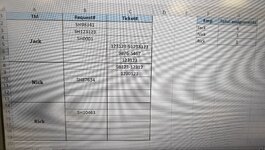Sorry guys for the blurred image. I need count the total assignings for employees based on the first table. There are two different categories (requests and tickets) and the total of both has to be derived in the total assigned column in second table. Thanks guys!
-
If you would like to post, please check out the MrExcel Message Board FAQ and register here. If you forgot your password, you can reset your password.
Count of total requests assigned
- Thread starter Jonam711
- Start date
mumps
Well-known Member
- Joined
- Apr 11, 2012
- Messages
- 14,248
- Office Version
- 365
- 2010
- Platform
- Windows
Try:
VBA Code:
Sub CountRequests()
Application.ScreenUpdating = False
Dim v As Variant, i As Long, dic As Object, k As Variant, rng As String
v = Range("A2", Range("A" & Rows.Count).End(xlUp)).Value
Set dic = CreateObject("Scripting.Dictionary")
For i = LBound(v) To UBound(v)
If Not dic.exists(Range("A" & i + 1).MergeArea.Address(0, 0)) Then
dic.add Range("A" & i + 1).MergeArea.Address(0, 0), Nothing
Cells(Rows.Count, "F").End(xlUp).Offset(1) = v(i, 1)
rng = Range("A" & i + 1).MergeArea.Offset(, 1).Resize(6, 2).Address(0, 0)
Cells(Rows.Count, "G").End(xlUp).Offset(1) = WorksheetFunction.CountA(Range(rng))
End If
Next i
Application.ScreenUpdating = True
End Sub
Upvote
0
Thank you very much. It can't be derived with formulas? As my office people prefer it.Try:
VBA Code:Sub CountRequests() Application.ScreenUpdating = False Dim v As Variant, i As Long, dic As Object, k As Variant, rng As String v = Range("A2", Range("A" & Rows.Count).End(xlUp)).Value Set dic = CreateObject("Scripting.Dictionary") For i = LBound(v) To UBound(v) If Not dic.exists(Range("A" & i + 1).MergeArea.Address(0, 0)) Then dic.add Range("A" & i + 1).MergeArea.Address(0, 0), Nothing Cells(Rows.Count, "F").End(xlUp).Offset(1) = v(i, 1) rng = Range("A" & i + 1).MergeArea.Offset(, 1).Resize(6, 2).Address(0, 0) Cells(Rows.Count, "G").End(xlUp).Offset(1) = WorksheetFunction.CountA(Range(rng)) End If Next i Application.ScreenUpdating = True End Sub
Upvote
0
Thanks but we won't be mentioning the numbers. We update the request number and need the count of it. In the formula provided I see there is SUMThe merged cells make the formula more complicated but try:
Book2
A B C D E F 1 2 Jack 1 Jack 6 3 1 Nick 3 4 1 Rick 1 5 1 6 1 7 1 8 Nick 1 9 1 10 1 11 12 13 14 Rick 15 1 16 17 18 19
Cell Formulas Range Formula F2:F4 F2 =MAP(E2:E4,LAMBDA(m,SUM(--(FILTER(B2:C19,SCAN("",A2:A19,LAMBDA(a,b,IF(b="",a,b)))=m)<>"")))) Dynamic array formulas.
Upvote
0
It worked, awesome. Let's say the cells are not merged and the emp name stays in the first cell of their request assigned how the formula looks plesseClear out the cells below. It's a spill formula.
Upvote
0
Cubist
Well-known Member
- Joined
- Oct 5, 2023
- Messages
- 2,487
- Office Version
- 365
- Platform
- Windows
- MacOS
It'd be simpler if each row had a name, but it'd be similar to the merged cells.It worked, awesome. Let's say the cells are not merged and the emp name stays in the first cell of their request assigned how the formula looks plesse
| Book2 | |||||||||
|---|---|---|---|---|---|---|---|---|---|
| A | B | C | D | E | F | G | |||
| 1 | Drag down | Spill formula | |||||||
| 2 | Jack | A | Jack | 6 | 6 | ||||
| 3 | B | Nick | 3 | 3 | |||||
| 4 | C | Rick | 1 | 1 | |||||
| 5 | D | ||||||||
| 6 | E | ||||||||
| 7 | F | ||||||||
| 8 | Nick | G | |||||||
| 9 | H | ||||||||
| 10 | I | ||||||||
| 11 | |||||||||
| 12 | |||||||||
| 13 | |||||||||
| 14 | Rick | ||||||||
| 15 | J | ||||||||
| 16 | |||||||||
| 17 | |||||||||
| 18 | |||||||||
| 19 | |||||||||
Sheet3 | |||||||||
| Cell Formulas | ||
|---|---|---|
| Range | Formula | |
| G2:G4 | G2 | =MAP(E2:E4,LAMBDA(m,SUM(--(FILTER(B2:C19,SCAN("",A2:A19,LAMBDA(a,b,IF(b="",a,b)))=m)<>"")))) |
| F2:F4 | F2 | =SUM(--(FILTER($B$2:$C$19,SCAN("",$A$2:$A$19,LAMBDA(a,b,IF(b="",a,b)))=E2)<>"")) |
| Dynamic array formulas. | ||
| Book2 | |||||||||
|---|---|---|---|---|---|---|---|---|---|
| A | B | C | D | E | F | G | |||
| 1 | Drag down | Spill formula | |||||||
| 2 | Jack | A | Jack | 6 | 6 | ||||
| 3 | Jack | B | Nick | 3 | 3 | ||||
| 4 | Jack | C | Rick | 1 | 1 | ||||
| 5 | Jack | D | |||||||
| 6 | Jack | E | |||||||
| 7 | Jack | F | |||||||
| 8 | Nick | G | |||||||
| 9 | Nick | H | |||||||
| 10 | Nick | I | |||||||
| 11 | Nick | ||||||||
| 12 | Nick | ||||||||
| 13 | Nick | ||||||||
| 14 | Rick | ||||||||
| 15 | Rick | J | |||||||
| 16 | Rick | ||||||||
| 17 | Rick | ||||||||
| 18 | Rick | ||||||||
| 19 | Rick | ||||||||
Sheet3 | |||||||||
| Cell Formulas | ||
|---|---|---|
| Range | Formula | |
| G2:G4 | G2 | =MAP(E2:E4,LAMBDA(m,SUM(--(FILTER(B2:C19,A2:A19=m)<>"")))) |
| F2:F4 | F2 | =SUM(--(FILTER($B$2:$C$19,$A$2:$A$19=E2)<>"")) |
| Dynamic array formulas. | ||
Upvote
0
Solution
Similar threads
- Replies
- 2
- Views
- 130
- Replies
- 0
- Views
- 118
- Replies
- 0
- Views
- 128






